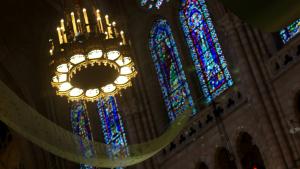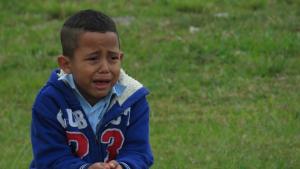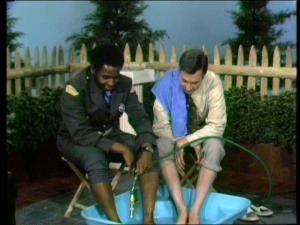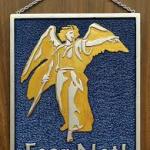A Curious Community
Matthew 28:16-20
Genesis 1:27-28
A version of this sermon was preached at Calvary Baptist Church on Trinity Sunday in 2008. Here’s a reprise!
I just love today’s Gospel passage. The disciples met Jesus up on a Galilean mountain and it was a joyful reunion. Then Jesus gave them marching orders to go out into the world and make disciples of all nations, baptizing them in the name of the Father and the Son and the Holy Spirit—some of the most familiar verses in the entire New Testament—what we’ve come to call The Great Commission.
And Matthew includes three little words that make it all make sense, to me anyway:
“But some doubted.”
Devout Jews that they were, they knew, from the time they could talk, the Shema: “Hear, oh Israel, the Lord our God is one God!” They knew this truth about God inside and out.
But here they were, gazing at this one they’d experienced as human, like them, but had come to believe, in some undeniable way, was divine also. And there he was, talking about sending them something called “the Spirit.”
Even for those who may not be very mathematically gifted, it’s easy to figure out that comes to three, not one.
And so, understandably . . . some doubted.
Today is Trinity Sunday, the one Sunday of the entire church year when we do not start our Sunday morning consideration with the teachings of Jesus or the words of the scripture text, but with a very difficult teaching of the church: the Doctrine of the Trinity.
You know, God is three in one, but really one even though God is also three?
And hopes for ease of understanding are not buoyed when one cracks open the commentaries and reads opening sentences like: “There are some themes for preaching that are both daunting for the preacher and puzzling for the congregation.”
Or, even when the preacher turns to the timeless writings of Church fathers, like Augustine, who wrote in his great and cumbersome work, The City of God, these helpful statements: “The Father is God. The Son is God. The Holy Spirit is God. The Son is not the Father. The Father is not the Holy Spirit. The Holy Spirit is not the Son.” And, finally: “There is Only One God.”
And some doubted.
And you can see why.
See, we believe in a three-in-one God, but the word “trinity” does not occur anywhere in holy scripture, and while there are texts that hint at some kind of Trinitarian doctrine, there’s nothing in all of scripture that defines this essence of God.
It was a guy named Tertullian, an early leader of the church, who actually invented the word “trinity” and the formula we’ve come to understand as our best bet for explaining: three persons, one substance.
But did you know that before we all agreed on a Christian doctrine of the Trinity, the first church had to argue. And argue and argue and argue, for hundreds of years, to even be able to articulate anything even resembling a unified doctrine?
See, after Tertullian made his big pronouncement about trinity, everybody got confused. Nobody could decide what status to assign Jesus and the Holy Spirit . . . who came first and who was made out of what. Here’s a quick summary of the good, the bad and the ugly:
The first Ecumenical council of the church was held in 325 AD in Nicea. The question up for debate was whether or not Jesus was divine, and in the end the church affirmed Jesus’ divinity and wrote the Nicene Creed, you know: “We believe in one God, the Father Almighty, maker of heaven and earth . . . .”
Then, about 50 years later in Constantinople, the gang got together again, this time to talk about the nature of Christ and the person of the Holy Spirit. Some people were teaching that Jesus was totally divine and not human, but that argument ended at this meeting when Jesus was voted 100% human. And folks were wondering about the relevance and the reality of the Holy Spirit, so the Trinity was defined and affirmed again, you know: three persons, one substance.
And . . . that settled that, until about 50 more years, in 431 AD, when the pendulum swung back and folks were concerned that some were taking the “Christ as human” thing too far, forgetting that he was God. So, they all decided at this meeting, the Council of Ephesus, that Jesus was, in addition to being 100% human, also 100% divine.
Well then, you guessed it, about 20 years later, in 451 AD, they all had to gather again, this time in Chalcedon, to argue about whether Jesus was, in fact, fully divine and fully human, or whether that assertion made him something else altogether.
And so it went.
These meetings sound humorous now, but believe me, they were no joke. People were kicked out of the church and labeled heretics. Fancy theological words were created to define the essence of the different parts of the Trinity (and, I am convinced, make the future life of any divinity student even more complicated).
And all of this is one really long way of saying that we do not do a very good job at defining an essential doctrine of our faith: the Trinity. When we’re not fighting over miniscule shades of gray regarding the essence of God, we’re either shrugging our shoulders in surrender or throwing our hands up in frustration. We don’t do the Trinity well and as a result . . . well, some doubted.
And some still doubt.
The fact of the matter is, we don’t have a nice way of explaining everything, you know, something we can print up in brochure form and pass out for easy reference.
In fact, turns out we’ve spent all this time trying to define God, to “make God in our own image,” as it were, using a metaphor—the Trinity—that helps a little but certainly doesn’t give us any easy answers.
So, it’s a good thing we get a clue for how to live with the tension of trying in vain to explain something that is, in essence, pure mystery, in our Hebrew lesson today. When we crack open the very first chapter of our Bibles and read the story of creation, we find out that we are created in the image of God, rather than the other way around.
“Then God said, ‘Let us make humankind in our image, according to our likeness; and let them have dominion over the fish of the sea, and over the birds of the air, and over the cattle, and over all the wild animals of the earth, and over every creeping thing that creeps upon the earth.’ So God created humankind in his image, in the image of God he created them; male and female he created them.”
Turns out, on Trinity Sunday it’s not our job to explain the essence of God, a mystery if ever there was one. Instead, it’s our job to learn the essence of the one in whose image we are created, and then live with brave abandon into the essence of who we’re meant to be.
And who we’re meant to be, according to the little picture of God we can see, the little picture we’ve decided to call “the Trinity,” is a people whose basic character is defined by relationship.
Just think: God is to us a divine being, holy beyond our understanding, who dictates rules for living and sets expectations far beyond what we could ever achieve.
And, we also know God to be intimately human, a God who has walked a mile in our moccasins, who knows the pain of being human, who understands our inability to meet divine standards and who has felt the frustration of grief and failure and brokenness.
And, we also know God as the breath and Spirit of new life, blowing into our world and into our lives, offering us possibilities we could never have imagined and sparking new life and energy when rules and expectations of faith begin to weigh us down.
And with all these expressions of God, some that seem more real to us at different times in our lives, we understand the truth that Augustine articulated: There is only one God. Creator, redeemer, sustainer, a God who relates to our world in many different ways and at the same time is, in essence, the very embodiment of loving relationship.
Characteristics that seem in conflict instead exist in creative community, divine presence, three in one, offering us the challenge of taking all the beautiful parts of who we are as diverse and multi-faceted expressions of God’s creation, somehow recognizing the very essence of God imprinted on each one of us, and living with courage into the kind of community God models for us.
Thomas Troeger, a Presbyterian pastor and gifted preacher, tells a story of an experience he had once. He wrote:
“One day several years ago I was in a department store buying myself a new shirt when a complete stranger walked up to me and said, ‘You must be Henry Troeger’s son.’
I looked at this person and I said, ‘I don’t believe I have ever seen you.’
He said, ‘Oh, no, you have never met me at all, but a long time ago I worked with your father. I was a close colleague of his and when I saw you across the aisle of the store, I said to myself, `I’d know that face anywhere.’ You are the very image of your father.’
For several weeks after that, I would sometimes be going down the street, and maybe come around a corner, and catch my reflection in a store window. [I started to see myself] with the eyes of someone else. It is not like looking into the mirror in the morning. I would come around the corner, catch that reflection and I would think, ‘That’s Henry Troeger.’ All of a sudden I would be seeing how I bore the image of my father.”
And so it is with us.
Each one of us is created with the image of God indelibly imprinted on our souls, so that, in some miraculous and inexplicable way, the diverse expressions of God that are you and you and you and me all come together to illustrate the mystery, to live together in community as we do our best to display for the world all the possibilities that the divine imprint on all of us could mean.
Just think: if we started to live into the mystery of the trinity, then it might just be possible for us to look at each other and see, not all the differences about how we look or speak or see the world, but rather an intricate relationship, a curious community, created in the image of God and living out the possibility for unity, even in our diversity.
Can you imagine?
Some have their doubts that this could ever really happen. Some are still doubting.
Doubts are par for the course with the mysterious God we worship—diverse and unified all at once. But the power of the Trinitarian metaphor becomes real when we live it out: unity even in diversity, different experiences fusing together to create a beautiful mosaic of God’s possibilities for the world.
It’s a curious community we’re called to embody, but how can we do anything less?
“Let us create humankind in our image.”
And some doubted.
Today, on Trinity Sunday, we are invited to help those disciples, and all of us who doubt, believe…to live boldly into the dream of the Trinity, the dream of everything we can be together.
We are after all, each one of us, created in the very image of God. Thanks be to God.











